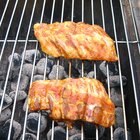NatashaBreen/iStock/GettyImages
One of the most impressive cuts of meat for the barbecue is beef back ribs, sometimes labeled as dinosaur ribs or dino bones because of their size. They're the rack of ribs that's cut away from a prime rib roast to turn it into a boneless ribeye, and they have a remarkably rich beefy flavor. Unfortunately, even though they're cut from the tender ribeye, the meat between the bones is tough and chewy. Slow-cooking them on your barbecue is one way to make them tender and give them a pleasantly smoky flavor.
Preparing the Ribs
Place the rack of beef ribs on your cutting board with the hollow of their curve facing upward. Unless your butcher removed it for you, the back will be covered by a thick, creamy-colored sheet of membrane. Use the tip of a knife to lever part of this membrane away from the ribs, then grasp it firmly with your hand and pull the whole sheet away.
Cut the rack into individual ribs or serving portions of two to three ribs each. You can cook the whole rack as one piece, but it's much easier to handle in smaller portions and more of the meat is exposed to the flavor-generating smoke and flame of the barbecue.
Rub the surface of the ribs thoroughly with your favorite dry spice rub or spice paste. Let them rest for at least 30 minutes and as long as overnight in your refrigerator, so the spices can adhere properly to the meat and begin to infuse flavors into the beef.
Barbecuing the Ribs
Light a bed of coals in your kettle and adjust the vents until they're burning evenly but gently. Move the coals to one side of the kettle, adding a few pieces of hardwood for smoke if you wish. If you're using a gas grill, light the side burners but leave the middle turned off. Wrap your hardwood chunks in heavy foil, then pierce the wrapper a few times with a skewer. Place this over one of the lit burners.
Position the ribs evenly over the unlit section of the grill, where they'll be gently cooked by indirect heat from the coals or gas flame. Close the lid. Adjust the vent and draft of your charcoal kettle, or the flame of your gas grill, until it reaches a stable temperature of approximately 225 to 250 degrees Fahrenheit.
Slow cook the ribs at that temperature for 3 to 4 hours, until the meat is tender and pulls easily away from the bone when tested with a fork.
Glaze the ribs, if you wish, by brushing them with a sauce or glaze. Then, open the vents on your charcoal grill or turn your gas grill to high. Finish the ribs for a few minutes at this temperature, until the glaze bubbles and caramelizes.
Transfer the ribs to a serving platter and serve them with your choice of side dishes.
Related Articles

How to Cook Pork Ribs on a Propane Grill

How to Cook Haddock on the Grill

How to Cook Wild Boar Ribs

How to Cook Beef Tenderloin on a ...

How to Heat Up Smoked Pork Ribs

How to Cook Salmon on a Griddle

How to Cook Pork Chops on an Electric ...

How to Make Rib Racks for Smokers

The Best Way to Cook Pork Shoulder Ribs ...
How to Cook Pork Rib Slabs

How to Cook Boneless Country Spare Ribs

How to Cook a Chuck Short Rib

How to Convection Roast a Brisket

How Do I Cook Spare Ribs in an Electric ...

How to Use an Offset Smoker to Cook a ...

How to Cook a Pork Spare Rib Brisket ...
How to Cook Goat Steak

How to Bake a Pork Loin Center Half

How to Cook a Goose on the Grill

How to Cook Barbecue Chicken Drumsticks ...
References
Tips
- Some cooks wrap the ribs in heavy aluminum foil after 2 to 2 1/2 hours, typically with a splash of sauce or a flavorful liquid such as wine or beer. This prevents evaporation from cooling the surface of the ribs as they cook and keeps them moister when finished. However, it does soften the crusty surfaces the ribs acquire from the barbecue's heat, which some diners consider to be the best part of the ribs.
Writer Bio
Fred Decker is a trained chef and prolific freelance writer. In previous careers, he sold insurance and mutual funds, and was a longtime retailer. He was educated at Memorial University of Newfoundland and the Northern Alberta Institute of Technology. His articles have appeared on numerous home and garden sites including GoneOutdoors, TheNest and eHow.